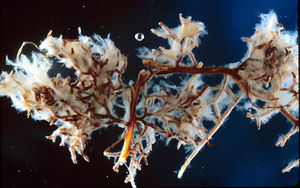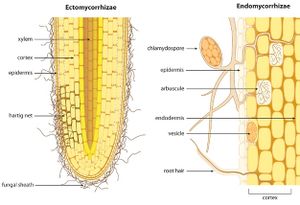Ectomycorrhizal Fungi

Ectomycorrhizal (ECM) fungi form symbiotic relationships with Plant roots. Only about 2% of the plant species on earth form endomycorrhizal relationships, but therein exist some of the most environmentally and economically important species. [1] EcM fungi tend towards specificity when choosing hosts, while Arbuscular Mycorrhizal Fungi is much more generalized in its choosing.
Structures

Mantle
A layer encasing the outside of the root tip in either a loose gathering or tight alignment of hyphae. The presence of the mantle can sometimes hinder root hair growth if the root is secured tightly.
Hartig net
A network of hyphae strands that work around root cells, as they make their way through the cortex towards the middle of the root.
Extraradical hyphae
A fine network of hyphae that extend outward from the encased root, filling the role of the suppressed root hairs. By spreading out into the surrounding soil, the hyphae can extract water and nutrients for transport back to the root.
Fruiting bodies
The most recognizable part of an EcM relationship is the fruiting body. These growths are usually easy to spot with the naked eye. The function of the fruiting body is sexual reproduction to spread the fungus to new hosts.
References
[1] Tedersoo, Leho; May, Tom W.; Smith, Matthew E. (2010). "Ectomycorrhizal lifestyle in fungi: global diversity, distribution, and evolution of phylogenetic lineages" (PDF). Mycorrhiza. 20 (4): 217–263. doi:10.1007/s00572-009-0274-x. PMID 20191371.
[2] Dighton, J. "Mycorrhizae." Encyclopedia of Microbiology (2009): 153-162.
[3] Smith, Sally E.; Read, David J. (26 July 2010). Mycorrhizal Symbiosis. Academic Press. ISBN 978-0-08-055934-6.